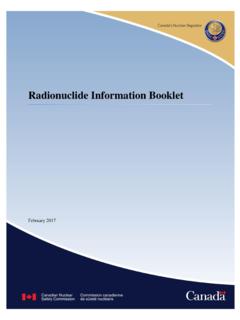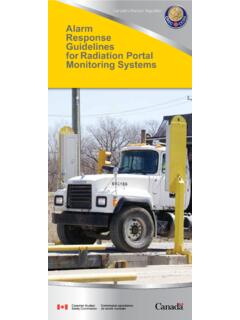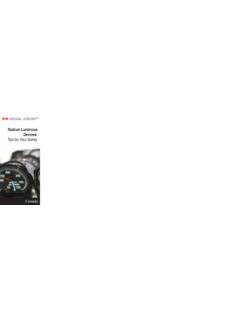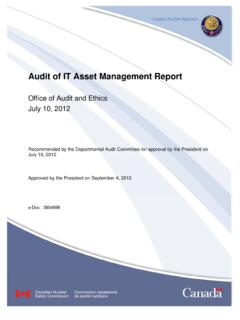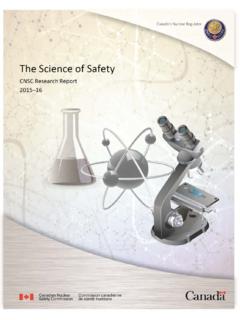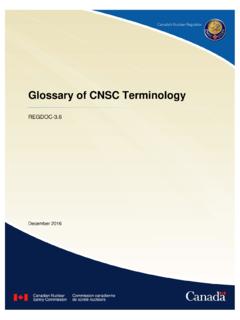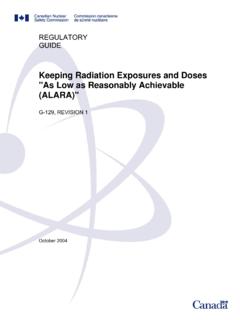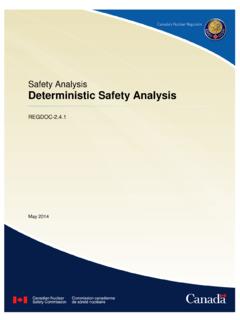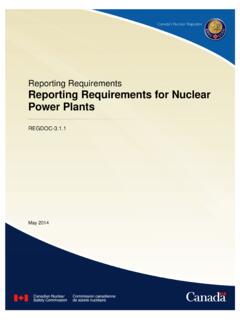Transcription of Fact Sheet - Tritium - Nuclear Safety
1 Tritium December 2012 Tritium is a radioactive form, or isotope , of hydrogen. It has two neutrons where regular hydrogen does not have any, which makes Tritium unstable and therefore radioactive. It is produced naturally from interactions of cosmic rays with gases in the upper atmosphere. It is also produced as a by-product of Nuclear reactors. Like all radioactive isotopes, Tritium decays. As it decays it gives off, or emits, beta radiation. One of the more common uses of Tritium involves glow-in-the-dark lighting and signs. Tritium gas is combined with phosphor to create luminescence. The light source does not require electricity or electrical wiring, making it ideal for exit signs, emergency lighting in commercial buildings and airplanes and for airport runway lights. Tritium is also used as a tracer in biomedical and academic research.
2 Some countries use Tritium as fuel for thermonuclear weapons, although Canada is committed to Nuclear non-proliferation. In the future, Tritium may also be used to generate electricity in fusion reactors which are currently under development. The Canadian Nuclear Safety Commission (CNSC) regulates releases of Tritium by Nuclear reactors and Tritium processing facilities to ensure the health and Safety of workers and the public, and the protection of the environment. Quick Facts Tritium is a radioactive form of hydrogen that occurs both naturally and as a by-product of the operation of Nuclear reactors. One of the more common uses of Tritium involves glow-in-the-dark lighting and signs. Tritium exposure can pose a health risk if it is ingested through drinking water or food, inhaled or absorbed through the skin in large quantities.
3 The CNSC regulates releases of Tritium by Nuclear reactors and Tritium processing facilities to ensure the health and Safety of workers and the public, and the protection of the environment. Tritium 2 Canadian Nuclear Safety Commission Radiation Dose The effect of the radioactivity on the body is called a radiation dose and is expressed in sieverts (Sv), or more commonly, in millisieverts (mSv), which are one one-thousandth in size. Tritium in Drinking Water The most common form of Tritium is tritiated water (HTO). This happens when a Tritium atom replaces a hydrogen atom in water (H2O) to form HTO. HTO has the same chemical properties as water and is also odourless and colourless. The standard international unit for measuring radioactive decay or radioactivity is the becquerel (Bq). The amount of Tritium in water is measured in becquerels per litre (Bq/l).
4 Water with a Tritium activity of 1 Bq/l, contains less than 1 Tritium atom per 100,000 million million (1 in 1017) molecules. The highest average annual Tritium level measured in the drinking water of Canadian communities neighbouring Nuclear facilities is about 18 Bq/l. This is well below drinking water limits recommended by Health Canada of 7,000 Bq/l. Tritium in the Body Some of the Tritium released into the environment will be naturally incorporated into nutrients such as carbohydrates, fats, or proteins. This is called organically bound Tritium (OBT). OBT can enter the body directly by eating tritiated food. OBT poses a slightly greater health risk because as an organic material, the body will retain it longer than tritiated water. This means that there is a greater likelihood that the Tritium atom will decay while in the body and possibly cause damage.
5 Generally speaking, OBT is at much smaller concentrations in the body than tritiated water. Health Effects Tritium is a relatively weak source of beta radiation. The beta particle itself does not have enough energy to penetrate the skin. However, it can pose a health risk if taken directly into the body in extremely large quantities; for example, a person would need to take in billions of becquerels before seeing a health effect. Tritium molecules can enter the body by breathing air containing Tritium , or by ingesting tritiated food and water. Tritiated water can be absorbed through the skin like regular water. Most Tritium leaves the body as tritiated water in urine, breath moisture and perspiration. Most inhaled tritiated hydrogen gas is exhaled immediately. A radiation dose from Tritium is like a radiation dose from any other type of radiation, including natural background radiation and doses received during medical procedures.
6 In Canada, members of the public receive annual doses of radiation from Tritium of to millisieverts (mSv), although very few, if any, members of the public receive doses in the upper end of this range. Near Nuclear facilities, where Tritium levels are slightly higher, the average annual dose to adults is about mSv. These doses are well below the public dose limit of 1 mSv as set in the Radiation Protection Regulations, and the average Canadian dose due to natural background radiation of mSv. Tritium Canadian Nuclear Safety Commission 3 Studies have not shown health effects at a chronic exposure below about 100 mSv. The regulatory public dose limit of 1 mSv is equivalent to 1% of this amount. Regulating Tritium Small amounts of Tritium are released to the environment mostly from reactor operation and maintenance and during the manufacture of Tritium light sources.
7 The CNSC imposes Derived Release Limits (DRLs) that restrict the amount of radioactive material that may be released. Releases must also be as low as reasonably achievable a concept known as ALARA and as a result, actual releases of Tritium from Nuclear facilities have typically been less than 10% of the DRL. The CNSC requires all Canadian Nuclear operators to provide quarterly reports on monitoring results for routine radioactive discharges, and annual reports on environmental monitoring programs. Licensees are also required to report any accidental or unmeasured releases of Nuclear substances into the environment. Tritium Studies Project In 2007, the CNSC launched the Tritium Studies Project, a multi-year research project on Tritium releases in Canada and an evaluation on the best practices of Tritium processing facilities around the globe.
8 The project has expanded the body of knowledge on Tritium . Six studies have been published, as well as a synthesis report that rolls up the conclusions and makes recommendations for regulatory improvements. These include actions to make the regulation of Tritium even safer, protect future drinking water resources and enhance environmental compliance monitoring. All of the studies are available on the CNSC Web site, in the Reading Room. To better regulate Tritium releases in Canada, the CNSC continues to conduct research on Tritium environmental behaviour and health effects in technical collaboration with several national and international partners. For more information: 1-800-668-5284 (in Canada) 613-995-5894 (outside Canada)

